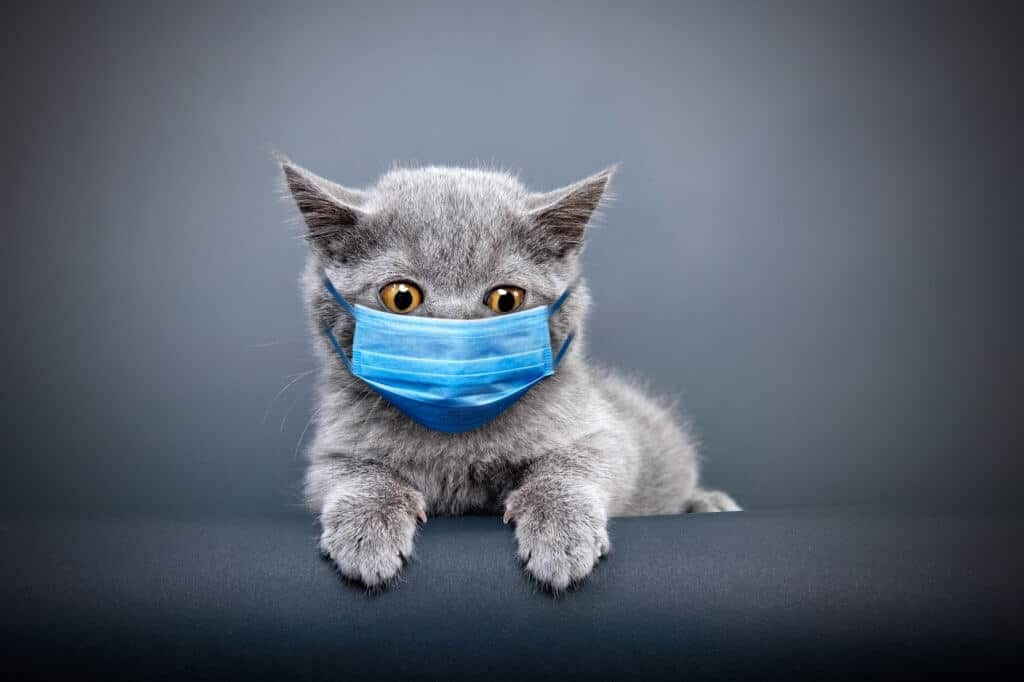Toxoplasmosis is among the most common parasitic diseases in the world. It infects both humans and animals, including our beloved cats.
According to experts, at least 20 to 60% of cats have been infected by toxoplasmosis at some point in their lives. Half of these cases are caused due to the transmission of contaminated food or infected meat.
The good news is that once a cat is infected with toxoplasmosis, he’s usually immune to reinfection for the rest of his life. However, systemic infections do occur. In some cases, these infections can be fatal if left untreated.
This article discusses the most common symptoms of toxoplasmosis in cats. Let’s dive right in!
Table of Contents
The Most Common Symptoms of Toxoplasmosis in Cats
Toxoplasmosis is a parasitic disease caused by Toxoplasma gondii, a single-celled parasite capable of infecting almost all warm-blooded animals. Some of the most common symptoms of toxoplasmosis include fever, lethargy, weight loss, diarrhea, and loss of appetite. In severe cases, a cat may suffer from pneumonia, inflammatory eye problems, and neurological issues.
Symptoms of Toxoplasmosis in Cats, Explained
In most cases, cats infected with T. gondii rarely need treatment, as symptoms are usually mild and would disappear within a few weeks. It rarely leads to serious problems and is almost always treatable.
However, some cats are more susceptible to falling severely ill to the disease than others. Toxoplasmosis is more likely to occur in cats with weakened immune systems and cats with Feline Leukemia Virus (FeLV) or Feline Immunodeficiency Virus (FIV).
Young kittens and pregnant cats may likewise face some of the more serious symptoms of toxoplasmosis. If left unchecked, they may develop long-term health risks like liver disease and respiratory issues.
If you believe your cat has toxoplasmosis, keep an eye out for some of these symptoms.
Fever

Cats with toxoplasmosis often develop flu-like symptoms like fever, lethargy, body aches, and fatigue.
Healthy cats suppress the development of T. gondii by forming tissue cysts containing bradyzoites, which prevents the replication of the tachyzoites (growing life stage of T. gondii). Cats with suppressed or ineffective immune systems allow the development of said organisms, thereby causing bodily inflammation and other feline infections that cause fever and the like.
Respiratory Issues
Toxoplasmosis may cause respiratory issues like asphyxia, breathlessness, increased mucus secretion, nasal discharges, and frequent sneezing.
In severe cases, toxoplasmosis may turn into pneumonia, which further increases breathing difficulties.
Toxoplasmosis that causes respiratory infections is dubbed pulmonary toxoplasmosis.
Neurological Issues
Late-stage toxoplasmosis may cause neurological symptoms in cats, including:
- Tremors
- Seizures
- Loss of balance
- Lack of coordination
- Hyperactive reflexes
- Reluctance or refusal to use the litter box
- Noticeable change in gait
CNS (Central Nervous System) toxoplasmosis directly alters a feline’s brain chemistry and may even control and change the cat’s behavior. Unfortunately, researchers are yet to understand why toxoplasmosis affects the central nervous system, but the parasite is linked to many behavioral and neurological disorders in cats.
Even if your cat doesn’t have CNS toxoplasmosis, it’s worth paying a veterinarian a visit if he shows any of the mentioned symptoms above. Neurological issues in cats are no joke and may quickly develop into something worse if not caught early.
Diarrhea

Diarrhea in cats is usually caused by parasitic and bacterial infections, so such a symptom is far from surprising. If you notice your cat expelling semi-liquid or liquid stools for more than two days, consult a veterinarian straight away. This is especially true if it’s paired with vomiting, inappetence, and signs of abdominal pain.
Swollen Lymph Glands
Swollen lymph nodes are a common symptom in sick cats. Cats infected by toxoplasmosis experience swollen lymph nodes all over the body. They appear like round “balls” under the skin, typically found in the sides of their neck, in front of their shoulder, and behind both their knees.
If you frequently pet your cat, you’ll easily notice the difference. The bumps are firm and fairly prominent.
Loss of Appetite
Loss of appetite is among the most common signs of toxoplasmosis in cats. In severe cases, untreated toxoplasmosis can trigger toxoplasma cachexia.
Alongside systemic inflammation, cachexia is characterized by acute anorexia, which can lead to significant loss of body weight in cats. Although rare, toxoplasma can reduce a cat’s body mass to up to 20% in just a few months.
If you notice a significant change in your cat’s appetite, contact your veterinarian straight away so he can rule out the possibility of a more serious disease.
Related Posts:
– How to Know if My Cat Suffers from Nasal Polyps?
– Most Common Signs of Lyme Disease in Cats
– Signs of Respiratory Infection in Cats
– What Are The Signs of Intestinal Blockage in Cats?
Jaundice
For those who aren’t aware, feline jaundice is the yellow discoloration of a cat’s eyes, skin, gums, ear flaps, and footpads.
Jaundice is usually a sign of a serious illness. In the case of toxoplasmosis, jaundice occurs in the final stage of the disease. This means that the illness has infected the cat’s liver.
Jaundice also occurs in kittens born with toxoplasmosis. When this happens, the mom cat would have already been infected with toxoplasmosis during the pregnancy stage.
Inflammatory Eye Problems
Toxoplasmosis that affects a cat’s eyes is called ocular toxoplasmosis. Ocular toxoplasmosis can cause inflammatory eye problems like redness, reduced vision, blurred vision, sensitivity, and sometimes tearing.
If you notice your cats bumping into objects or flinching or squinting in bright light, this might be a sign of a parasitic infection. The same is said if your cat frequently hides in dark areas to avoid the light.
Final Thoughts
Toxoplasmosis isn’t usually serious in healthy cats. In fact, the majority of cats infected with T. gondii don’t show symptoms at all.
Cats contract toxoplasmosis from eating wild animals, undercooked meat, and contaminated food infected with the parasite. T. gondii also develops in cat feces, where it can infect other cats once digested.
Some of the biggest symptoms of feline toxoplasmosis include respiratory and neurological issues, diarrhea, fever, swollen lymph nodes, and loss of appetite.
If your cat shows any of the above symptoms, please contact your veterinarian so he or she can perform the necessary tests. Treatment for toxoplasmosis is fairly simple; veterinarians usually prescribe antibiotics called clindamycin. In cases of eye infection, jaundice, and other physical symptoms, steroid creams or oral steroids are given to treat the eyes and other infected areas.

I’ve been living with cats since 2008 and I can confidently say I have more feline friends than humans lol. I currently live with 5 cats in different life stages; two of them are less than one year old, one is 2-ish years old and the oldest two are 9-ish years old. I’ve developed a strong bond with cats over the years and I’m eager to share my experience through this blog. You can learn more about my cats here.

